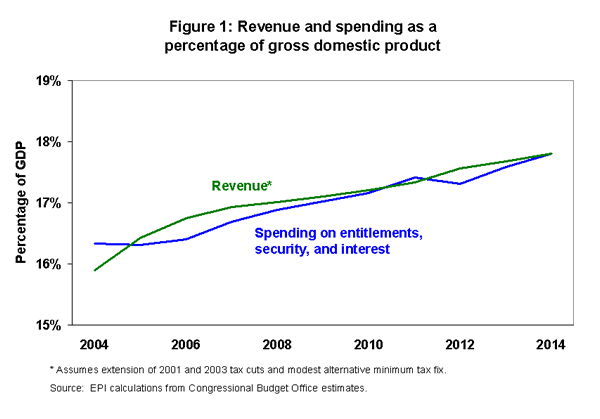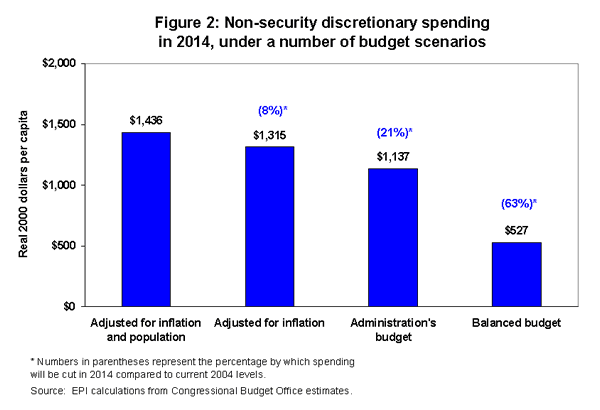See Snapshots Archive.
Snapshot for April 26, 2004.
Compassionate, sensible government on the chopping block
Debate over long-term budget policy tends to neglect spending on critical functions of government such as education, the environment, enforcement of federal laws, infrastructure, and new technology for medical care and manufacturing. Such “non-security discretionary” (NSD) spending effectively receives lower priority in budget procedures. For example, administration budget documents this year emphasize specific budget commitments on deficits, taxes, entitlements (such as Social Security and Medicare), defense, and homeland security. Sustaining its commitments in all those categories of the budget would require that the last remaining budget category, spending for NSD purposes, absorb all the adjustment.
The squeeze on NSD spending—currently 3.7% of gross domestic product—would be more apparent if the administration produced the customary 10-year budget numbers instead of just the five-year budget numbers that it has provided. The 10-year numbers consistent with administration policies paint a disturbing picture, especially given that the administration has argued in favor of making all the 2001 and 2003 tax cuts permanent. The green line in Figure 1 shows revenue as a share of GDP with the 2001 and 2003 tax cuts made permanent.

The administration’s goals of maintaining the tax cuts, moving toward a balanced budget, and keeping other spending policies intact leave almost no room for domestic discretionary spending. The blue line shows spending on entitlements, security (defense, homeland security, and international), and interest as projected by the Congressional Budget Office under the administration’s budget policies. This line actually understates the true administration budget policy because its budget omits any costs for Iraq or Afghanistan after September 30, 2004 and the costs of some expensive weapons systems.
The administration’s promise to cut the deficit in half over five years implies the goal of a balanced budget in 10 years. That goal cannot be achieved—while maintaining its policy commitments on tax cuts, entitlements, and security spending—without devastating cuts in fundamental government programs.
The U.S. government is currently spending $1,436 per person on non-security discretionary spending. As shown in Figure 2, that spending in 2014 would be cut:
- to 8% below the current level if NSD spending grows only with inflation and not with population,
- by 21% with the administration’s 2009 budget adjusted for inflation between 2009 and 2014 (and maintaining a budget deficit), and
- by 63% if the 2014 budget is balanced solely by cutting spending on non-security discretionary programs.

Today’s snapshot was written by EPI Research Director Lee Price.
